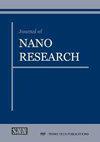Mechanism Study of Green Synthesis and Antibacterial Attribute of Polyalthia longifolia Based Gold Nanoparticles
IF 1
4区 材料科学
Q4 MATERIALS SCIENCE, MULTIDISCIPLINARY
引用次数: 0
Abstract
Drug resistant microbial strains are becoming continuous dilemma for researchers; hence, some alternates are required to combat this issue. In this way, nanotechnology is fascinating researchers to put forward a step in order to synthesize metals nanoparticles via adopting an ecofriendly, facile, and quick approach using medicinal plants. By means of aqueous extract of Polyalthia longifolia (AEPl), gold nanoparticles (AuPl) were synthesized for the mechanism study of synthesis and antibacterial bahavior. The reddish colored solution was an indicative clue of synthesis showing surface plasmon band at 540nm using UV/Visble spectroscopy. Various functional groups in the extract were identified which participated in the reduction of metal ions to metallic form as indicated from the Fourier Transform Infrared (FTIR) spectra of AuPl. Moving ahead, the synthesized AuPl were characterized through Transmission Electron Microscopy (TEM) showed spherical shape with more or less 50nm size. Besides, Scanning Electron Microscopy (SEM) study revealed some aggregates formation. Further, structural characterization via X-Rays Diffractometry (XRD) displayed crystallline nature of these nanoparticles. Finally, Energy Dispersive X-rays (EDX) analysis described their metallic form. The antibacterial activity at increased concentration when measured; AuPl showed 15 and 18mm bacterial growth inhibition zones against Escherichia coli and Bacillus subtilis at 100μg/mL concentration respectively. In addition, significant least minimum inhibitory concentration (MIC) and minimum bactericidal concentration (MBC) values of AuPl against these microbes were also observed. In the light of the above knowledge, it is inferred that the biogenic AuPl exhibit strong antibacterial potential enabling them to be a good substitute of antibiotics.长叶蓼基金纳米颗粒绿色合成及抗菌性能机理研究
耐药微生物菌株成为困扰研究人员的持续难题;因此,需要一些替代方案来解决这个问题。在这种情况下,纳米技术为利用药用植物采用一种环保、简便、快速的方法合成金属纳米粒子提出了新的思路。以长叶蓼(AEPl)水提物为原料,合成了金纳米颗粒(AuPl),并对其合成机理和抗菌性能进行了研究。红色溶液是合成的指示性线索,紫外/可见光谱显示表面等离子体带在540nm处。从AuPl的傅里叶变换红外光谱(FTIR)中发现,提取物中的各种官能团参与了金属离子还原为金属形态。通过透射电子显微镜(TEM)对合成的AuPl进行了表征,其形状为球形,尺寸约为50nm。此外,扫描电镜(SEM)研究还发现了一些聚集物的形成。此外,通过x射线衍射仪(XRD)的结构表征显示了这些纳米颗粒的结晶性质。最后,能量色散x射线(EDX)分析描述了它们的金属形态。测定浓度增加时的抗菌活性;在100μg/mL浓度下,AuPl对大肠杆菌和枯草芽孢杆菌分别有15和18mm的细菌生长抑制区。此外,还观察到AuPl对这些微生物具有显著的最小抑制浓度(MIC)和最小杀菌浓度(MBC)值。综上所述,生物源性AuPl具有很强的抗菌潜力,是抗生素的良好替代品。
本文章由计算机程序翻译,如有差异,请以英文原文为准。
求助全文
约1分钟内获得全文
求助全文
来源期刊

Journal of Nano Research
工程技术-材料科学:综合
CiteScore
2.40
自引率
5.90%
发文量
55
审稿时长
4 months
期刊介绍:
"Journal of Nano Research" (JNanoR) is a multidisciplinary journal, which publishes high quality scientific and engineering papers on all aspects of research in the area of nanoscience and nanotechnologies and wide practical application of achieved results.
"Journal of Nano Research" is one of the largest periodicals in the field of nanoscience and nanotechnologies. All papers are peer-reviewed and edited.
Authors retain the right to publish an extended and significantly updated version in another periodical.
 求助内容:
求助内容: 应助结果提醒方式:
应助结果提醒方式:


